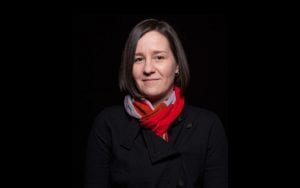CSHL’s Hammell finds link between altered protein and subset of ALS patients
By Daniel Dunaief
It’s a big leap from an encouraging start to a human, especially when it comes to deadly diseases like amyotrophic lateral sclerosis, or Lou Gehrig’s disease. Cold Spring Harbor Laboratory Associate Professor Molly Hammell knows that all too well.
Hammell has been studying a linkage between a mutated form of a protein called TDP-43 and ALS for eight years. About a year and a half ago, she worked with 178 human samples from the New York Genome Center’s ALS Consortium and found a connection between a subset of people with the disease and the presence of abnormal aggregate forms of the protein.
“It’s really rewarding to see evidence in clinical samples from the processes that we predicted from cell culture and animal models,” she explained in an email.

About 30 percent of the people with ALS Hammell examined had pathology of this protein in the upper motor neurons of the upper cortex. In this area, the mutated form of TDP allowed more so-called jumping genes to transcribe themselves. A normal TDP protein silences these jumping genes, keeping order amid potential gene chaos. The change in the protein, however, can reduce the ability of the protein to serve this important molecular biology maintenance function.
By using complementary studies of cell culture, the associate professor tried to determine whether knocking out or reducing the concentration of normal TDP caused an increase in these retrotransposons.
When she knocked out the TDP, she found a de-silencing of these jumping genes “was rapid,” she said. “We could see that in the samples we collected.”
Before she got the larger sample, Hammell worked with a smaller pilot data set of 20 patients. She found that three of the patients had this abnormal protein and an active set of these jumping genes.
“It’s hard to make an argument for something you’d only seen in three patients,” she said. “Getting that second, independent much larger cohort convinced us this is real and it’s repeatable, no matter whose patient cohort we’re looking at.”
Several diseases show similar TDP pathology, including Alzheimer’s and fronto-temporal dementia. She started with ALS because she believed “if we’re ever going to see” the link between the mutated protein and a disorder, she would “see it here” because a larger fraction of patients with ALS have TDP-43 pathology than any other disease.
The findings with ALS are a compelling start and offer a potential explanation for the role of the defective protein in these other conditions.
“We think it’s possible in a subset of patients with other neurodegenerative diseases that there might be overlapping” causes, Hammell said “We’re trying to get more data to branch out and better understand overlapping alterations.”
With these other diseases, she and her colleagues would like to explore whether TDP pathology is a necessary precondition in conjunction with some other molecular biological problems or whether these conditions can proceed without the disrupted protein.
The reaction among researchers working on ALS to Hammell’s finding has been encouraging.
Hemali Phatnani, the director of the Center for Genomics of Neurodegenerative Disease at the New York Genome Center, suggested Hammell’s work “opens up really interesting lines of investigation” into a potential disease mechanism for ALS. The research suggests a “testable hypothesis.”
Phatnani, who has been in her role for about five years, said she and Hammell speak frequently and that they serve as sounding boards for each other, adding that Hammell is “definitely a well-regarded member of the community.”
Hammell has also been working through the Neurodegeneration Challenge Network in the Chan Zuckerberg Initiative, or CZI. This work brings together scientists who study Alzheimer’s, Parkinson’s, ALS and Huntington’s diseases. The group works to develop new approaches to the treatment and prevention of these diseases. These scientists, which includes researchers from Harvard University, Stanford University, Vanderbilt and Mount Sinai, among others, have webinars once a month and attend a conference each year.
Hammell was one of 17 researchers awarded the Ben Barres Early Career Acceleration Award from the CZI in 2018, which helped fund the research. She thinks the scientists from the CZI are excited about the general possibility that there’s overlapping disease mechanisms, which her work or research from other scientists in the effort might reveal. The CZI is “trying to get researchers working on different diseases to share their results to see if that’s the case,” she explained in an email.
She recognizes that numerous molecular and cellular changes also occur during the course of a disease.“There are always skeptics,” Hammell concedes. In her experiments, she sees what has happened in patient samples, but not what caused it to happen. She also has evidence that the retrotransposon silencing happens because of TDP-43 pathology.
“What we still need to confirm is whether or not the retrotransposons are themsleves contributing to killing the neurons,” she said.
If Hammell confirms a mechanistic link, other studies may lead to a treatment akin to the approach researchers have taken with viruses that alter the genetic code.
Future therapies for a subset of patients could include antiviral treatments that select specific genes.
Over time, she said her lab has cautiously added more resources to this work. As she has gotten increasingly encouraging results, she has hired more scientists who dedicate their work to this effort, which now includes two postdoctoral fellows, two graduate students and three staff scientists.
Some scientists in her lab still explore technology development and are devoted to fixing the experimental methods and data analysis strategies she uses to look for transposon activity.
Hammell is inspired by the recent results and recalled how she found what she expected in human samples about 18 months ago. She said she was “giddy” and she ran into someone else’s lab to “make sure I hadn’t done it incorrectly. It’s really exciting to see that your research might have an impact.”







